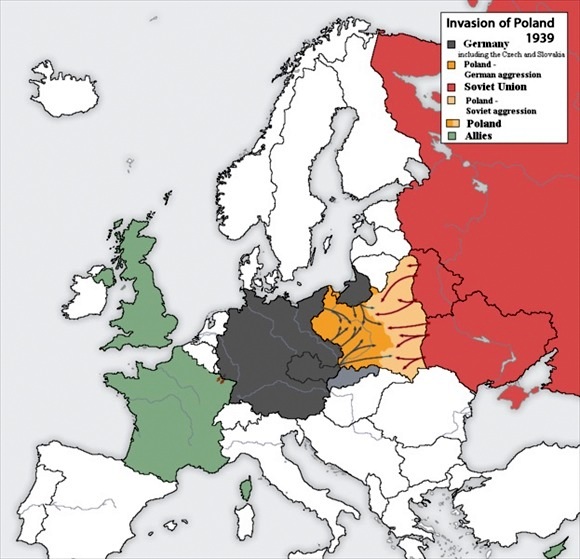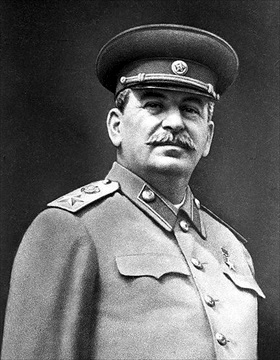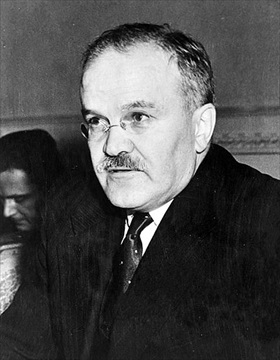STALIN TO HEAD SOVIET WAR EFFORT AGAINST GERMANY
Moscow, Soviet Union • July 1, 1941
Early in the morning of August 24, 1939, the foreign ministers of Nazi Germany and the Soviet Union signed a treaty of nonaggression, formally known by the two signatories’ names—the Molotov-Ribbentrop Pact, which bore the date August 23, 1939. Neither Foreign Minister Vyacheslav Molotov (who was also Soviet Premier) nor Joachim von Ribbentrop had anything to do with crafting the pact between the long-standing state enemies. Indeed, Soviet Communist Party Chairman Joseph Stalin was the prime mover in formulating the policy of nonintervention in each other’s affairs (reputedly in 48 hours) that led to the notorious pact. A secret codicil to the bilateral pact divided the nation states in Central and Eastern Europe between the treaty partners to follow Germany’s September 1, 1939, invasion of Poland, its neighbor to the east and the Soviet Union’s to the west (see map below).
Stalin’s rapprochement with his country’s ideological and political rival in 1939 and 1940 and his steadfast faithfulness to the terms of the 10–year Molotov-Ribbentrop Nonaggression Pact returned painful rewards to him and his nation in June 1941. Operation Barbarossa, Hitler’s perfidious invasion of his ally, kicked off on June 22 as 3.8 million men, 3,350 tanks, 2,770 aircraft, and 7,200 artillery pieces swept across the Soviet frontier that stretched from the Soviet-occupied Baltic States in the north to the Black Sea in the south. Within weeks the Soviets lost all the territories they had gained as a result of the Molotov-Ribbentrop Pact. In the same time frame Soviet defenders suffered 750,000 casualties, lost 10,000 tanks and 4,000 aircraft, and by the end of June lost 400,000 men to German captivity. (Within six months the Soviet military would suffer 4.3 million casualties and witness the capture of 3 million prisoners, two-thirds of whom would die in cruel captivity by February 1942. To these numbers must be added the hideous executions conducted by squads of German SS and Einsatzgruppen and the bloody pogroms and massacres performed by local populations against Jews as the Red Army retreated eastward.)
On June 30, 1941, a week after Adolf Hitler’s Wehrmacht had invaded their country, representatives of the top three tiers of Soviet government met to create the State Defense Committee, known by its Russian initials as GKO. The State Defense Committee would take direct responsibility for prosecuting the war against Nazi Germany. On this date, July 1, 1941, Molotov’s cabinet appointed Communist Party Chairman Stalin to head the GKO owing to his recognized authority and years of service to the cause of Soviet Bolshevism. Molotov was appointed deputy chairman. It would take almost four years and cost the Soviets 40 million combatant and civilian deaths (±10 million; the scope for error is very broad), plus millions more wounded, maimed, or simply lost in the Great Patriotic War before Stalin’s rousing July 3, 1941, call to “rise in defense of our native land” turned an apparent sure-fire Soviet defeat into an Allied victory over Nazi Germany.
 |
Above: Invasion and conquest of Poland by Germany and the Soviet Union in September and early October 1939. The coral-colored area overlaid with arrows represents Polish territory in the west that fell within the German zone of occupation, the lighter coral area represents Polish territory in the east that fell to the Soviets in accordance with the secret codicil appended to the Molotov-Ribbentrop Nonaggression Pact of August 23, 1939. The German invasion of Poland on September 1, 1939 (not the Soviet invasion of Poland on September 17), triggered World War II in Europe after Great Britain and France announced their intentions to fulfill their military-assistance obligations to Poland under terms of separate bilateral treaties, one of which was signed in London in the last week in August 1939. (The French would ratify their treaty a day after Britain and France declared war on Germany on September 3.) The Anglo-French-Polish treaties had no effect on what Poles called their 1939 Defensive War. By October 6, 1939, the colluding efforts of German and Soviet armed forces had effectively liquidated the Polish state.
 |  |
Left: Joseph Vissarionovich Stalin (1878–1953) was the ruthless leader of the Soviet Union from the mid-1920s until his death. He was born Josif Vassarionovich Dzhugashvili and adopted the name “Stalin”—in English, “man of steel.” He was short (between five feet four and six), broad chested, weighed about 190 pounds (86 kg), had a withered arm due to a childhood accident, and walked with a roll owing to a clubfoot. His mustached face, pockmarked by smallpox (airbrushed out in this heroic-looking portrait), was framed by large ears and offset by piercing hazel eyes. Without his cap his hair appeared slicked back. When he spoke his voice was harsh, revealing teeth darkened from heavy smoking. Holding the crucial positions of General Secretary of the Central Committee of the Communist Party of the Soviet Union and from May 1941 onward Chairman of the Council of People’s Commissars (the equivalent of a Western head of government), Stalin was effectively the dictator of the state, answerable to no one after having killed off or banished every conceivable opponent. The large star seen on Stalin’s shoulder board identifies him as a Marshal of the Soviet Union, a rank equal to a five-star general that the dictator gave himself in March 1943.
![]()
Right: Vyacheslav Mikhailovich Molotov (1890–1986) was a protégé of Stalin. Born Vyacheslav Skryabin, Molotov, like Stalin, adopted a new last name, which translates to “man who smites with hammer.” A plodding, dour, inscrutable bureaucrat who successfully negotiated the slippery, often deadly steps of Soviet cut-throat politics, Molotov served as Chairman of the Council of People’s Commissars from 1930 to 1941, and as Minister of Foreign Affairs from 1939 to 1949 and from 1953 to 1956. Among foreign service personnel, Molotov was known as “Stone Ass” for his ability to sit emotionless for as long as necessary in diplomatic discussions. After Molotov fell out of Stalin’s favor, he was spared an early death when the 74‑year-old Soviet dictator died five days after suffering a cerebral hemorrhage on March 1, 1953.
Operation Barbarossa, Hitler’s Disastrous Gambit, 1941
![]()

 History buffs, there is good news! The Daily Chronicles of World War II is now available as an ebook for $4.99 on Amazon.com. Containing a year’s worth of dated entries from this website, the ebook brings the story of this tumultuous era to life in a compelling, authoritative, and succinct manner. Featuring inventive navigation aids, the ebook enables readers to instantly move forward or backward by month and date to different dated entries. Simple and elegant! Click
History buffs, there is good news! The Daily Chronicles of World War II is now available as an ebook for $4.99 on Amazon.com. Containing a year’s worth of dated entries from this website, the ebook brings the story of this tumultuous era to life in a compelling, authoritative, and succinct manner. Featuring inventive navigation aids, the ebook enables readers to instantly move forward or backward by month and date to different dated entries. Simple and elegant! Click 











